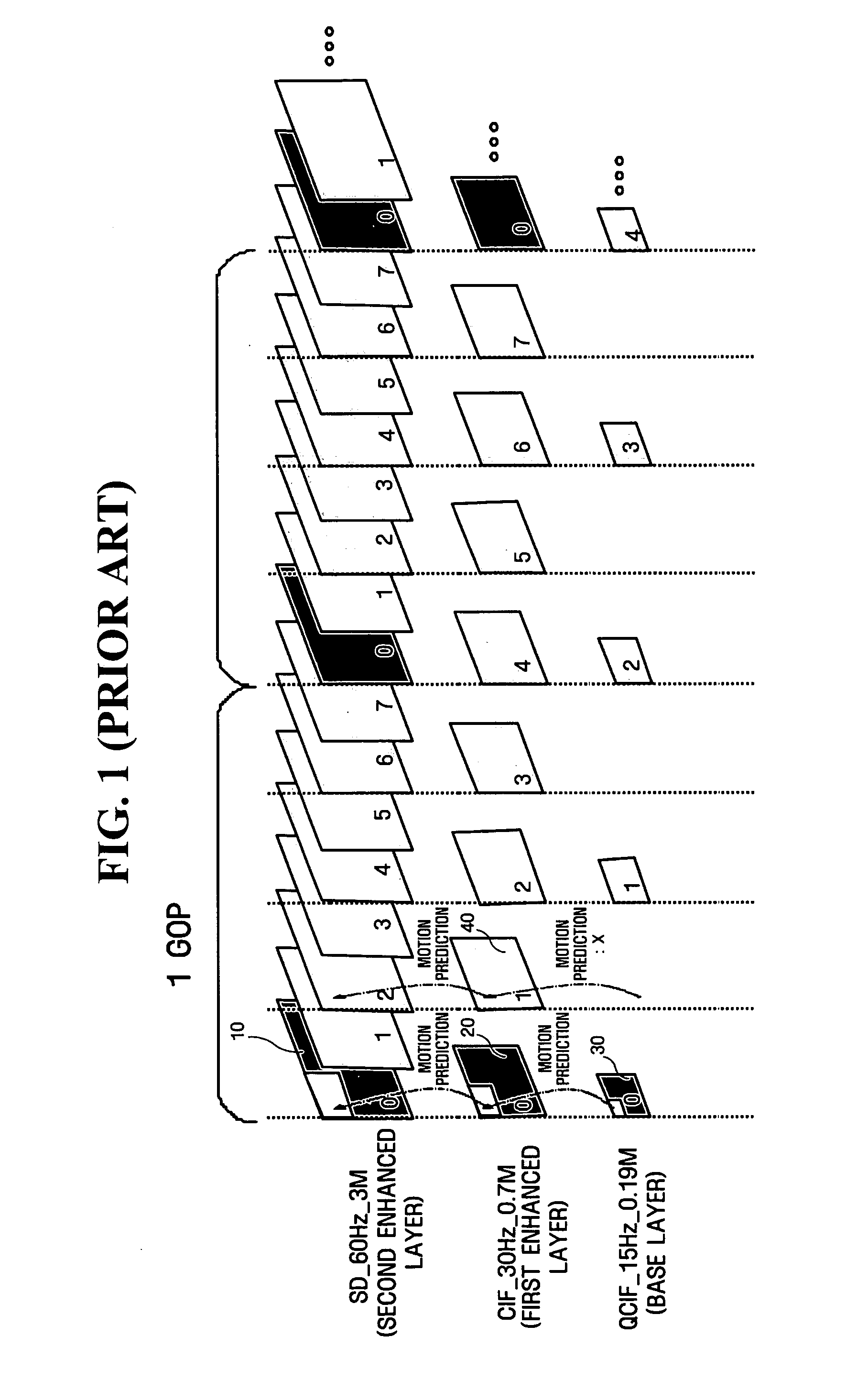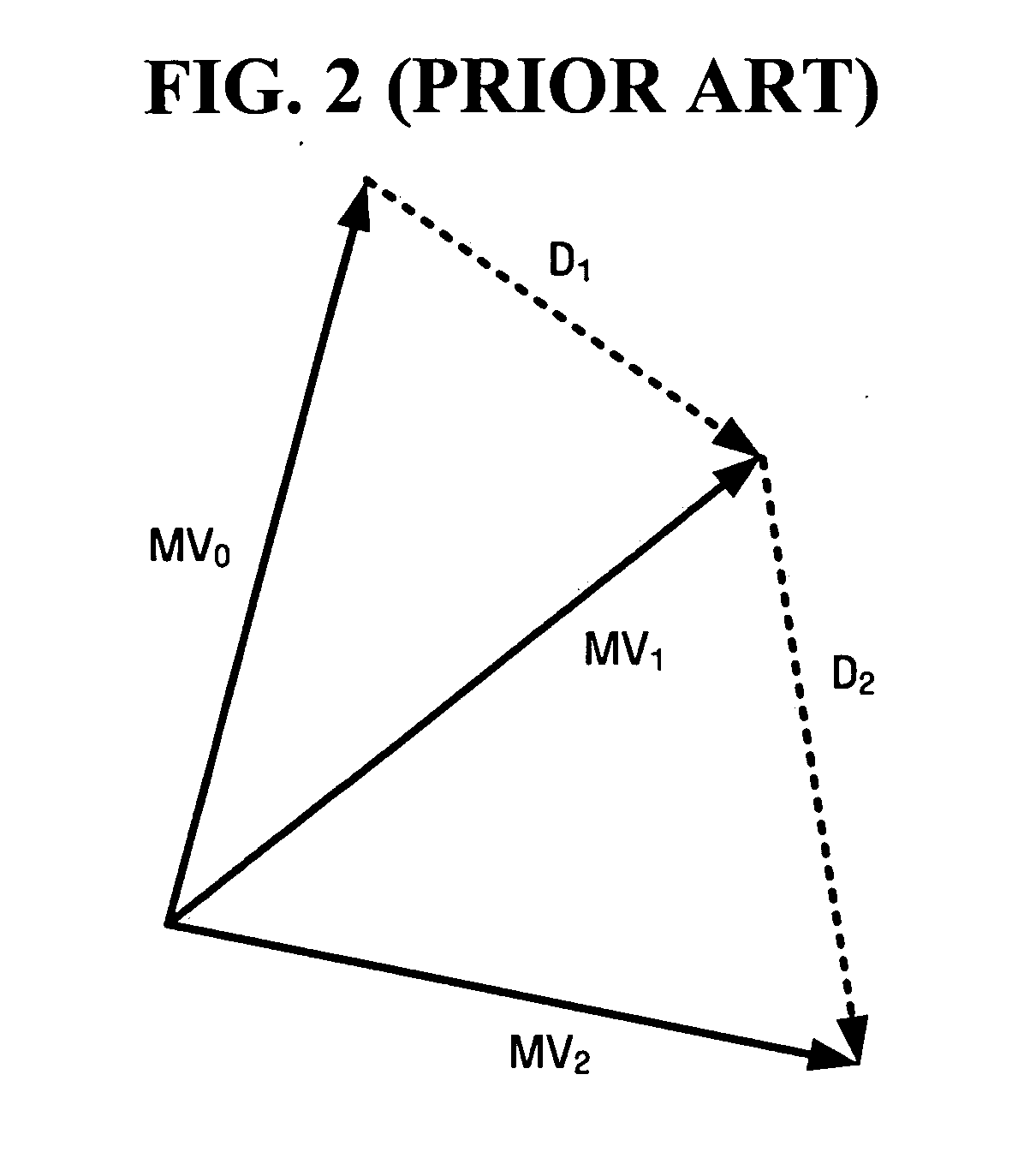Method and apparatus for effectively encoding multi-layered motion vectors
a multi-layered motion vector and motion vector technology, applied in the field of video compression, can solve the problems of difficult task of efficiently redundancy between motion vectors, high effort is being made to implement scalability based on multi-layered structure, etc., and achieve the effect of efficient encoding multi-layered motion vectors
- Summary
- Abstract
- Description
- Claims
- Application Information
AI Technical Summary
Benefits of technology
Problems solved by technology
Method used
Image
Examples
first exemplary embodiment
[0054] A virtual motion vector is used as a motion vector in an unsynchronized frame of a current layer. When a motion vector in the unsynchronized frame has the same direction as a motion vector in a mother frame as shown in the Equations (1) through (3), the virtual motion vector is obtained by multiplying the motion vector in the mother frame by the ratio of temporal referencing distance between layers (e.g., ½). When the motion vector in the unsynchronized frame has an opposite direction to the motion vector in the mother frame, the virtual motion vector is obtained by multiplying the power by −1.
[0055] Furthermore, since sub-macroblock patterns in an unsynchronized high-pass virtual frame of the current layer are the same as those in the mother frame, a motion vector in the unsynchronized frame is predicted using sub-macroblock patterns in the mother frame. Thus, motion vector search and R-D optimization for selecting a sub-macroblock pattern are not performed for the unsynchr...
second exemplary embodiment
[0056] In the second exemplary embodiment, sub-macroblock patterns in an unsynchronized frame and a mother frame are determined by a separate R-D optimization process. While a virtual motion vector is derived from the mother frame after completing the R-D optimization, the sub-macroblock patterns in the mother frame are different from those in the unsynchronized frame. When the sub-macroblock patterns are different, a motion vector from a sub-macroblock in the unsynchronized frame can be induced from a virtual motion vector overlapped by the sub-macroblock pattern in the unsynchronized frame. To achieve this, the present invention uses the weighted average of the areas of overlapped regions.
[0057]FIG. 6 shows an example in which a sub-macroblock pattern in a mother frame corresponding to a sub-macroblock in an unsynchronized frame is further divided into sections. Here, Mvi and Ai respectively denote a virtual motion vector obtained as defined by the Equations (1) through (3) and t...
third exemplary embodiment
[0059] The third exemplary embodiment focuses on each pixel of a virtual frame. First, a check is made as to all motion vectors passing through a pixel of the virtual frame. A virtual base motion vector for one pixel (“pixel motion vector”) is estimated by a distance-weighted average (distance between centers of the pixel and sub-macroblock). Various distance measures such as Euclidean distance or City Block distance may be used for distance estimation.
[0060] A sub-macroblock pattern in an unsynchronized frame is decided by an R-D optimization process. When a motion vector in the unsynchronized frame is replaced by a virtual motion vector, virtual base motion vectors for the sub-macroblock are estimated using all pixel motion vectors within the same sub-macroblock in the virtual frame. FIG. 8 illustrates a method for estimating virtual base motion vectors.
[0061] A motion vector for a pixel of interest 50 in a virtual frame is derived from motion vectors passing through the pixel. ...
PUM
 Login to View More
Login to View More Abstract
Description
Claims
Application Information
 Login to View More
Login to View More - R&D
- Intellectual Property
- Life Sciences
- Materials
- Tech Scout
- Unparalleled Data Quality
- Higher Quality Content
- 60% Fewer Hallucinations
Browse by: Latest US Patents, China's latest patents, Technical Efficacy Thesaurus, Application Domain, Technology Topic, Popular Technical Reports.
© 2025 PatSnap. All rights reserved.Legal|Privacy policy|Modern Slavery Act Transparency Statement|Sitemap|About US| Contact US: help@patsnap.com



